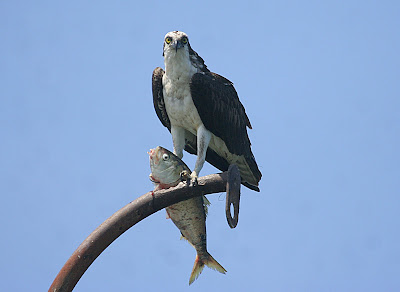 I only had a few moments to check on the tern colony at Cockenoe Island, as I was motoring out Norwalk Harbor, I couldn't help but notice an osprey hovering and then stooping, it was a quickly repeated movement, I put the boat in neutral and stood fast.
I only had a few moments to check on the tern colony at Cockenoe Island, as I was motoring out Norwalk Harbor, I couldn't help but notice an osprey hovering and then stooping, it was a quickly repeated movement, I put the boat in neutral and stood fast.What this female osprey (the one in the above photo) was doing, was following a Double-crested Cormorant that was searching sub surface for a fish or two for lunch, the osprey would hover, following very slowly, just before the cormorant would surface the osprey started it's stoop from fifty or so feet, and meet the cormorant with talons extended as soon as the cormorant surfaced.
I watched six stoops, the corm never came up with any food and finally the osprey retired to her nest. My photos were way too out of focus to show.

The Cockenoe Island sand spit is a very busy place right now,
The Least Terns are renesting after their loss of nest and eggs from last weeks moon tides.
The Common Terns are doing very well, since they nest just a bit higher in the sand than the Least, in the bottom middle of this photo is a few day old Common Tern chick, with parents on either side scolding another tern, telling it not to land here.

Bottom bird is an adult Oystercatcher with it's three healthy chicks above, the youngsters are quickly molting into adult plumage, but still have dark colored bills.
Their bills will slowly change to the bright orange of the adult in the nest several months.
You saw these same chicks a few weeks ago on past blogs.
A few pair of Oystercatchers that lost their clutches are now renesting.

There were about three hundred Common Terns around the sand spit today, this seems to be an ordinary photo of a C Tern posing on a rock.
Click on the photo to enlarge and note the banding ring on its leg, my closeup shows a possible letter H on it.
I have yet to research it but I will. If anyone has the data on hand, please chime in.

I'm cruising along and note this Great Egret flying side by side with the boat, I snap a few shots, then realize it's flying the same course that I am navigating, we stay together for over a mile.
I look at the boats GPS and see that the bird and I are cruising at 19.2 knots, with a 4-5 kt head wind off the birds and my port bow! In mph this puts us at about 22mph.
These birds fly very leisurely, I've had races with Bald Eagles and many other birds that blow by me when I'm over 30 mph, and those birds were not cranking it up.

Osprey chicks are starting to show, this undisclosed local nest is not far above the high tide line.
Note how the chicks lay down to become one with the nest.
Please don't get upset that I was to close to the nest, again I am shooting at 400mm and these pics are cropped most likely past 2-3,000mm, Photoshop helps big time with the clarity.

If it weren't for the orange eyes they would be invisible.

This Great Blacked-backed Gull chick is now learning to hang out in the one to two inch surf.
By the wetness of it's feathers, I'm guessing a boat may have come by, leaving a wake large enough to give this bird a bath? Or maybe it just took one?


































+copy.jpg)


